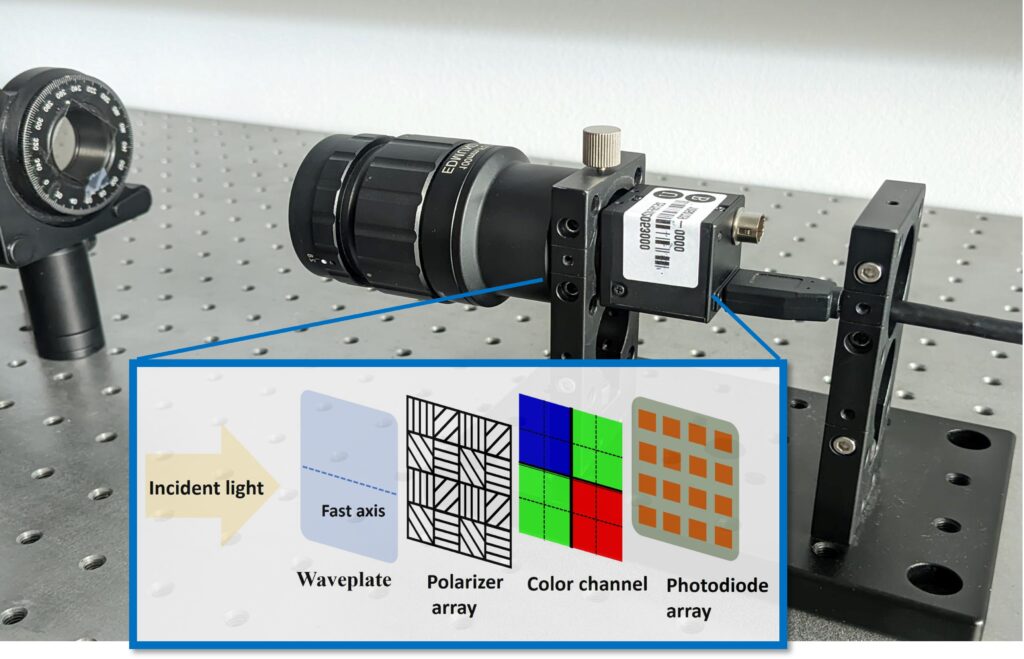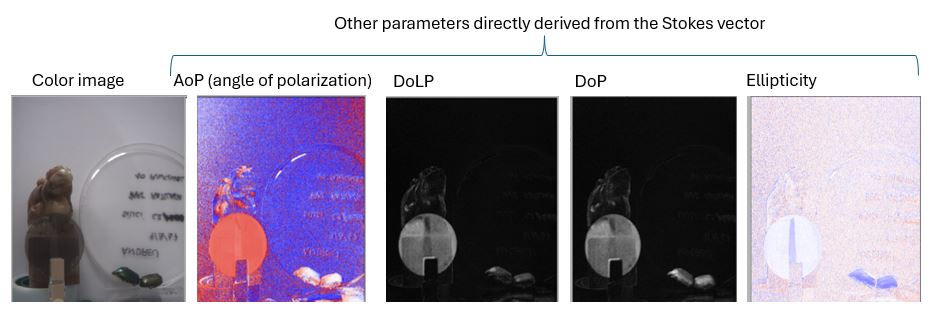Our Full-Stokes Polarization Camera technology introduces a new approach to capturing the complete polarization state of light in real-time, including the often-overlooked circular polarization. To the best of our knowledge, this is the smallest and simplest fully operational Full-Stokes camera developed to date.
Key Technical Features
- Complete Stokes Vector Measurement
Measure all four Stokes parameters—total intensity (S₀), linear polarization components (S₁, S₂), and circular polarization (S₃)—in a single shot, enabling detailed analysis of light’s polarization state. Results can also be shown in terms of the degree of circular polarization (DoCP), degree of linear polarization (DoLP), and angle of linear polarization (AoLP) - Innovative Dispersive Retarder Technology
A homogeneous waveplate with natural wavelength-dependent retardation is positioned before the sensor. This component introduces precise phase shifts across RGB color channels, allowing differentiation of polarization states without the need for complex or costly microretarder arrays. - Optimized for Real-Time Performance
With an effective resolution of 612 × 512 pixels for each Stokes parameter and a frame rate of up to 75 frames per second or 24 frames per second (after noise-reduction averaging), the system is designed for real-time applications without sacrificing accuracy. - Seamless Compatibility
Built on a commercial polarized color camera ( Sony IMX250MYR sensor), the system integrates effortlessly into existing workflows. Its compact design maintains standard camera dimensions, requiring no additional bulk or power.
How It Works?
The Full-Stokes Polarization Camera utilizes the wavelength-dependent retardance of a custom waveplate to produce well-controlled phase shifts across the sensor’s RGB color channels. By analyzing polarization states at different wavelengths—primarily through the red and green channels—the system reconstructs the complete Stokes vector, under the assumption that the input polarization is not strongly wavelength-dependent. A custom calibration procedure ensures accurate performance, accounting for parameters such as retardance, depolarization, and retarder orientation.
What Kind of Retarder Does the Camera Use?
The system employs a custom-made elliptical retarder, specifically designed to introduce optimal phase differences between the red and green channels of the camera sensor.
How Has the Camera Been Modified?
The only modification required is the addition of the custom retarder to a commercial color polarization camera. No other changes are necessary, and the system contains no moving or active polarization components.
How Is the Full Stokes Vector Calculated?
The full Stokes vector is computed in real time by the computer connected to the camera. The algorithm combines information from the red and green channels to reconstruct the polarization state. The calculation is straightforward and could potentially be implemented directly in the camera’s onboard electronics or FPGA.
What Are the Camera’s Limitations?
Since the method relies on combining data from two color channels, both must receive sufficient signal. For example, the system cannot function correctly under purely monochromatic green illumination. As a result, the camera must generally be used with a broadband light source or under ambient lighting conditions that span the relevant spectral range.
Which are are the output’s of the camera?
Stokes parameters can also be expressed in terms of other parameters directly related to the polarization of light (AoP, DOP, Ellipticity, etc) . For example, all these 5 images can be simultaneously provided by the camera:
Applications
- Advanced Imaging/Vision: Achieve enhanced image quality by analyzing polarization effects in scenes, ideal for scientific research and industrial inspections or imaging in harsh environments (underwater vision, navigation through the fog, etc).
- Remote Sensing: Capture detailed polarization data for environmental monitoring, atmospheric studies, and geological surveys.
- Augmented Reality & Display Technology: Enhance user experiences by integrating both linear and circular polarization insights into AR systems or display designs, improving contrast and realism.
Why detecting also circular polarization?
Circular polarization is an important but often underutilized aspect of light’s polarization state, offering valuable insights into light-matter interactions that go beyond linear polarization analysis. While our Full-Stokes Polarization Camera is not sensitive enough to detect very subtle effects like molecular chirality, it excels in practical applications where circular polarization provides macroscopic information about surfaces, materials, and environments. For example, circular polarization can enhance target detection by distinguishing between natural and artificial materials, reducing glare in challenging scenes, and improving visibility in turbid media like fog or water. Additionally, it can reveal stress-induced birefringence (see the second video as an example), surface roughness, and other material properties critical for industrial inspections, remote sensing, and imaging in harsh environments.
Examples
The first video shows a real-time Stokes vector imaging of a scene comprising two perpendicular polarizers and a rotating achromatic waveplate in front of a linear polarizer. At the top of the scene, there are also 3D glasses with filters of opposite circular handedness.
The second video shows a scene recorded while varying the stress applied to a glass microscope slide (BK7 glass) by pressing it with fingers. A laptop screen generating a horizontal linear polarization state serves as the background (S₁ close to 1). When pressure is applied to the edge of the glass slide, stress is immediately induced, leading to birefringence due to the photoelastic effect, that the camera detects as some circular polarization (S₃), reaching the camera.ss
The camera offers quantitative results for all Stokes parameters. For example, this is a quarter-wave plate being rotated in front of a polarizer.

